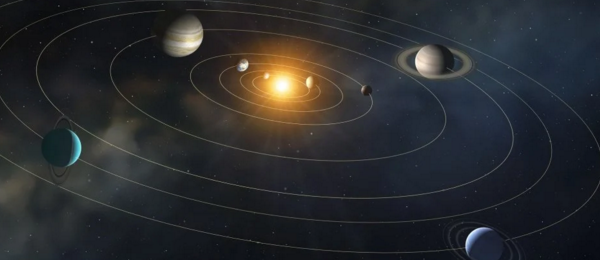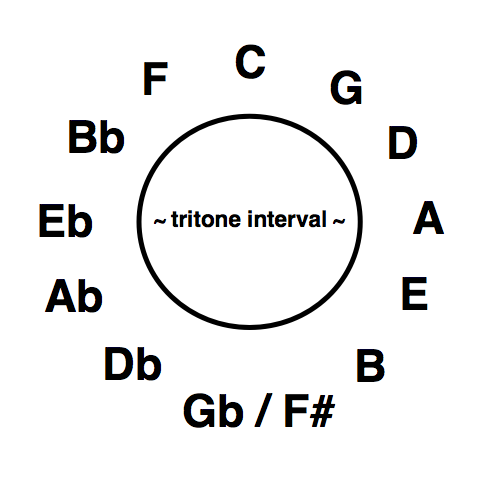~ seven notes ~ '7' ~ seven letters ~
|
In a nutshell ~ diatonic realm. If there's a music theory 'nutshell best of them all' in this e-book, it's this one; the diatonic realm. For by mastering its 'silent puzzle' of pitch organization, so much else in music just makes way better sense, and eventually ... perfect sense :) For when we learn songs and discover new coolness, the 'diatonic realm' is the 'domain' organizer of the musical notes, and shows how their organization can reflect off one another in various songs. Given just its seven notes and a desire to learn, one's understanding of the 'patterns and loops' of pitches, (shown below in chart form), that structure our diatonic realm can happen very quickly, even leading to a rather dramatic evolve of anyone's big music theory pic. Thus, the 'nutshell of all nutshells' designation. |
We can see by the following picture that the Sun centers the planets. This is what the 'diatonic realm' is. For once we choose a key for our song, as in the key of 'C' major, it becomes the centering Sun and the number One, and with it's bright illuminating light and pull of gravity, the other planets become the other pitches in the diatonic scale and all together create the 'realm', each planet sized in their general importance determined in part by each individual song. For while there's well worn pathways of how our pitches flow, if the art demands something new, then inventing the new it shall be. While the idea of diatonic is a whole tamale of sorts, a wide open vista of possibilities, there's a few key aspects that clearly define any song written along diatonic lines and principles. So any folk, country, most pop and rock, jazz and beyond styled songs, all live in the diatonic realm. There's a chance of blue notes always, to jazz up diatonic melodies or not, and harmonies that are free to include any of the remaining five pitches beyond the core diatonic group of seven. |
And where the song will go. A key aspect of diatonic is 'where' a song's chords will go. And diatonically, there's really only a couple of places that we want to initially identify by ear. Termed throughout as the 'diatonic 3 and 3', which defines the three major and three minor triads available within a key center. And while there's more to this theory, as there always is in good art, there's also this simplicity of the '3 and 3' in too many of the Americana songs we love from centuries past now not to know a few, and which in loving hands today continues to create those memorable stories of lasting art. |
"Simplicity is the ultimate sophistication." |
wiki ~ Leonardo da Vinci |
'inside is diatonic' while 'outside is non-diatonic.' |
Diatonic is the nutshell ~ in / out ~ the legal :) When first venturing into music studies at the university I bumped right into the concept of 'inside / outside.' As my peers often defined the jazz music we played in just such a way, being either 'in or out' creates a perfect foundation for understanding our music to build on. So with the 12 unique pitches of our chromatic scale, turns out that being 'inside' means working within just the seven diatonic pitches of a key center. While 'outside' we define as including the remaining five pitches of the 12, that we often use to 'jazz up' our diatonic ideas. So in our out? Are the pitches we are using to create our music from the diatonic seven or non-diatonic five? Turns out that this is the theory basis for understanding our musics and has been for the last 300 years or so. So 'inside is diatonic' while 'outside is non-diatonic.' |
Inside the diatonic realm. BIG letters at the top of this page surely denote the importance of 'diatonic' in the scheme of understanding music theory ideas. Whole tamale level? Big picture, the basis of understanding it all? Yep, will be for some reading here. For as far back as we might ever go in our music histories, the term 'diatonic' and the myths and theories that surround its seven pitches have shaped our music. |
|
For our discussions here, we've two aspects to consider. First is that the 'diatonic scale' is the select group of seven pitches pitches for creating near all of our Americana melodies; it's our relative major / minor scale. Our second consideration most often becomes a simple theory question that helps define our whole analytical process; 'is the pitch (s) under scrutiny 'diatonic' to the key center of the music we wish to theoretically untangle? |
What we dig ~ untangle any pitches. So when we hear something we dig, ol' Curiosity just want to understand what's in this music, what makes it tick, what's its magic. Once we get to the source of it, know its theory, we can then recreate it and evolve its coolness in our own art. That most of our Americana music is diatonically generated makes our work a breeze. So when we bump into a pitch that's not 'one of the seven', say some 'blues hue' or borrow a note for a fancy non-diatonic chord, sourcing from the diatonic perspective gives us a consistent, structural basis to figure out what's going on and always be correct. |
Dia-tonic implies 'through the tones.' So to begin to understand this essential term and concept, we can define its two parts. And if this is 'all Greek' to ya, no worries, for that's the language where this word comes to us from. Rote memorize this please by creating your own sketch of the following chart. ~ D I A T O N I C ~
|
|
|||||||||||||
Early origins. In getting to the origins of this diatonic scale we bump right into its myth for we need to use the wayback machine to find its sources. And most anytime we use the wayback there's going to be some wiggle as to just what is what in the historical record we have today. So the artist in us often loves the myth that often surrounds the historical record human events, the very ones that inspire and energize to life the fantastical range of art we create. Using curiosity of a 'myth' to energize the creation of art has worked for untold generations. And for we 'moderne's today, myth also goes forward into the domain of 'sci-fi', imagining what will be. |
The first steady gig. With 'diatonic' we can go all the way back to when we as regular folks casa'd in caves and the steady gig, both matinees and evening shows, was at the communal camp fire. Most cats were probably drummers ... imagine that :) ... and of course everybody danced, well probably (see, there's that wayback wiggle). Recently, fragments of a bone flute were found in one such cave near the center of the European continent. When redesigned to imagined proportions and recreating a new one with '3d printing' wizardry, and placed in the hands of the local woodwind monsters, guess what scale pitches it plays? Hint, begins with a 'd' ... :) |
|
So, to believe or not to believe this possible myth is each our own prerogative. I believe of course, for I love the myths. For believing creates a potential for me to bring forth the ancient melodies, the ones that today might resonate with and bring together in love all our global humankind. And in doing so, help better our world's day to day through the music we each bring to life and share. And just imagine the dance moves these ol' melodies might provoke, yet it's all a myth or not ... imagine that. |
"Imagination is more important than knowledge." |
wiki ~ Albert Einstein |
The diatonic scale(s), 'relatives' and the 'modes.' In examining the enduring melodies of our Americana music over the last few centuries, from whatever source, we consistently find the seven pitches of the relative major / minor group and their modes as their basis. No surprise that we theorists also identify this group as the diatonic scale. And beyond our Americana, this grouping has been the core for creating melodies as far back as musicologists have yet been able to venture; in sound recordings, written historical records, books and instruments discovered in archeological adventures. |
Diatonic pitches for song in 'C' major. In our modern times of today, the idea of 'diatonic' creates our key centers. For example, in the key of C major, these seven unique pitches are termed its diatonic pitches. Ex. 1. |
diatonic scale formula |
. |
1 |
1 |
1/2 |
1 |
1 |
1 |
1/2 |
C major diatonic scale |
C |
D |
E |
F |
G |
A |
B |
C |
Diatonic pitches for song in A minor. Since C major has a relative minor, are these pitches the same diatonic pitches of A natural minor? Example 2. |
diatonic scale formula |
. |
1 |
1/2 |
1 |
1 |
1/2 |
1 |
1 |
A minor diatonic scale |
A |
B |
C |
D |
E |
F |
G |
A |
So the exact same pitches create C major and A minor? Yep. They form our core diatonic, relative major and minor pairing. And combined is a whole key center? Yep. And 12 of these makes the whole tamale? Ex. 3. |
diatonic C major scale |
C |
. |
D |
. |
E |
F |
. |
G |
. |
A |
. |
B |
C |
diatonic A minor scale |
A |
. |
B |
C |
. |
D |
. |
E |
F |
. |
G |
. |
A |
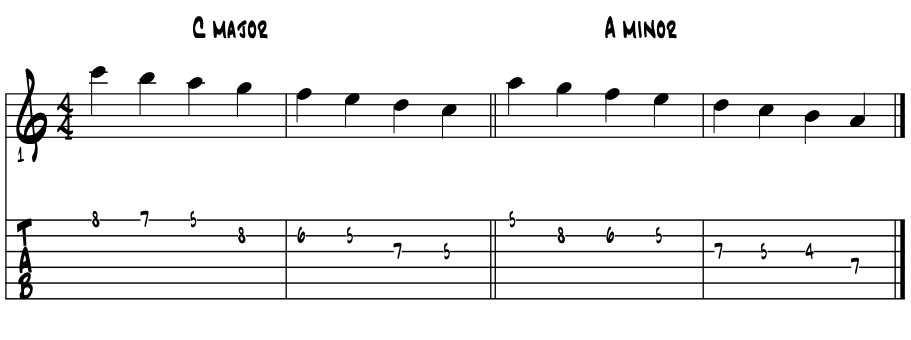 |
~ super theory game changer ~ |
Diatonic flip side / non diatonic pitches. Well we used seven pitches to make our diatonic relative groups. As we've just the 12 pitches of the chromatic scale, that leaves five pitches. Can we deduce that these five are then non-diatonic? Yes amigo mon ami, that is the case. Examine the non-diatonic pitches for C major. Ex. 4. |
numerical scale degrees |
1 |
b2 |
2 |
b3 |
3 |
4 |
b5 |
5 |
#5 |
6 |
b7 |
7 |
8 |
diatonic C major scale |
C |
. |
D |
. |
E |
F |
. |
G |
. |
A |
. |
B |
C |
non-diatonic pitches |
. |
Db |
. |
Eb |
. |
. |
Gb |
. |
Ab |
. |
Bb |
. |
. |
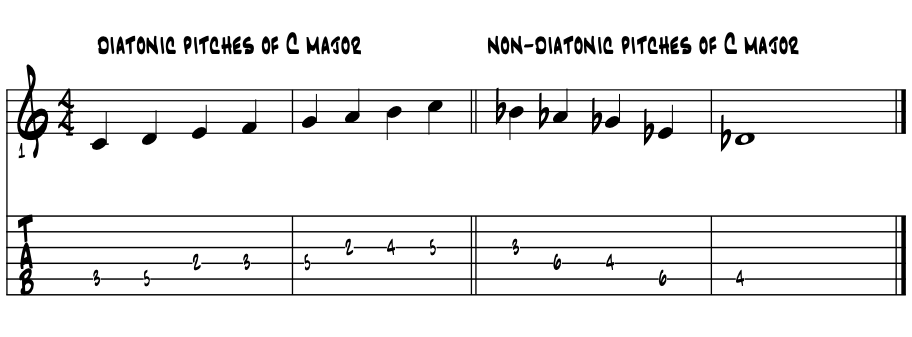 |
Cool? Very straightforward. So a pitch is either diatonic or not diatonic to a given key center? Exactly. This is the bottom line basis of how we sort the pitches. Any given pitch in any given spot in music is either one of the seven pitches of a key center or not. If it is it's diatonic. If not, it's non-diatonic and we theorists simply want to know from whence it came. And in that searching is its magic often revealed. As simple as that? Yep, allowing that we know the pitches of each key center and can aurally sense the non-diatonic sounds when they occur. |
This is why C major / A minor are our main keys for learning; no sharps or flats added to their pitches, just straight white keys on the piano. For if any accidental pops up in the music it kind of jumps right out. And the same theory applies to all of our paired 12 relative major / minor keys? Absolutely, 'one ring to rule them all.' Example 4a. |
 |
And these other five, non-diatonic pitches are ... ? Well, sorry to say there's at least a half dozen or more things they can be, all depending on where we find them in the music. Sometimes they're just a passing tone between diatonic tones of a key center. Sometimes a blue note. Sometimes the root or color tone of a non-diatonic chord used to take the music to a new key center, which itself has its own set of seven diatonic pitches. On and on? Yep, pretty much. Does it matter? |
Not really, as long as we theorists have a way to untangle and decipher the pitches, we can unlock their magic and understand the relationships. Thus empowered we have the means to create the magic whenever, wherever and whatever we may choose. Isn't this a main reason for understanding music theory in the first place? Sure is :) |
Thinking diatonically, all defined by key center. What creates these diatonic boundaries ? A key center. And a key center is? A select group of pitches that follows our ancient diatonic scale interval formula. Today, and for the last thousand years or so, this group has become known to us as the Ionian mode (major) and Aeolian mode (minor) which are our relative major / natural minor scale group of pitches. |
From this diatonic scale we create the largest and most inclusive perspective of our music theory. Why? Well they sound good and folks dig them and the music they create gets folks up to dance. Watch the dancers next time, you can and see how many of them are smiling and smiling = good we're having some fun :) Most of our songs, including the 'oldies' from the past millennia, are written and centered in these pitches. |
Quick review. The term diatonic, 'through the tones', is simply the way we define pitches in our tonally key centered musics. We pick one pitch to be our 'key' and build a seven pitch diatonic major or minor scale based on an ancient formula of whole steps and half steps. These pitches and only these pitches, we term to be 'diatonic' to that key center. The remaining five are non-diatonic. |
Diatonic triads. The vast majority of American music is diatonic and the diatonic triads are the basis of the chords or harmony of a song. We often ask, 'what key center is that triad diatonic to?' This helps us understand the theory as we've a key center created by a set of pitches to work from and lean against. |
~ super theory game changer ~ |
Diatonic chords / three and three. As our diatonic scale evolved in its tuning over the millennia, its ability to also create chords to support its melodies became manifest. With the arrival of an equal temper tuned 'piano forte' near the dawn of the 18th century, all was in place for diatonic harmony to continue to evolve in two essentials ways. First, composers now had all 12 pitches of the chromatic group equally available as both diatonic major or minor key centers as well as any color tone within any combinations of pitches. |
Second, in its Euro home, there's the span of 150 to 200 years or so from the more diatonic 'inside' to outside.' Here in our Americana we rocketed to the linear 'free' in about half that time, 80 years or so. That old time radio used to do some amazing things in getting the music out there and get folks excited, probably still does :) |
So the basis of the theory of diatonic harmony is created by building a three note triad on each of the seven pitches in the scale group. In the following chart we evolve scale to arpeggio and into the three note chords we term triads. Example 5. |
| scale numerical degrees | 1 |
2 |
3 |
4 |
5 |
6 |
7 |
8 |
| C major scale pitches | C |
D |
E |
F |
G |
A |
B |
C |
| Arpeggio numerical degrees | 1 |
3 |
5 |
7 |
9 |
11 |
13 |
15 |
| C major arpeggio pitches | C |
E |
G |
B |
D |
F |
A |
C |
| chord quality | I |
ii |
iii |
IV |
V |
vi |
vii |
VIII |
| triads | CEG |
DFA |
EGB |
FAC |
GBD |
ACE |
BDF |
CEG |
Well ain't that a beautiful thing. So in a diatonic world we only use the pitches of our diatonic scale to create our diatonic harmony. Yes amigo mon ami, that is indeed the case and has been for a long four hundred years or so. Further on back if you're a lute player. |
This now combined diatonic resource; a scale and its chords, is the musical basis for children's songs, folk, country, a lot of rock and pop and jazz. Everything but the blues? Yep, pretty much. Example 5a. |
 |
Run out of frets? So did I. Much easier on the piano. Is this why we oftentimes hear how the theory is perhaps easier to understand on a keyboard than guitar ? Could very well be. There are lots of ways to slice and dice these chordal critters to suit our musical needs. We could revoice them to stay in localized position with different string groups. Maybe find ways to use more open strings or both. Let's give this another try in G major / E minor Example 5b. |
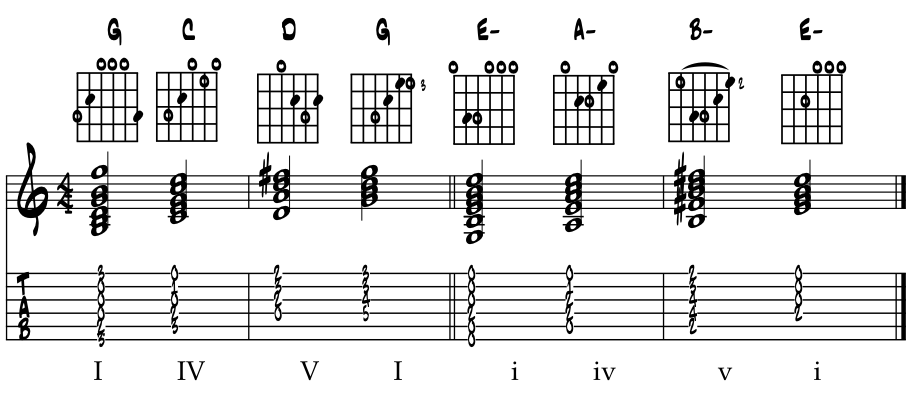 |
Look familiar from just above in the discussion? Way better chord shapes to feed this bulldog. |
Triads of the natural minor tonality. The following chart simply runs the same theory through the pitches of the relative, natural minor group. Exact same pitches now creating the minor tonal environment built upon the root pitch A, creating the relative natural minor scale and spelling out its seven diatonic triads. Same pitches as just used in the C major chart above, we're just starting from a different root. Using just open chords. Example 6. |
| scale numerical degrees | 1 |
2 |
3 |
4 |
5 |
6 |
7 |
8 |
| A minor scale pitches | A |
B |
C |
D |
E |
F |
G |
A |
| Arpeggio numerical degrees | 1 |
3 |
5 |
7 |
9 |
11 |
13 |
15 |
| C major arpeggio pitches | A |
C |
E |
G |
B |
D |
F |
A |
| chord quality | I |
ii |
iii |
IV |
V |
vi |
vii |
VIII |
| triads | ACE |
BDF |
CEG |
DFA |
EGB |
FAC |
GBD |
ACE |
 |
Easy enough yes? So ... same pitches reworked to create new musical settings. Any other ways to work and configure these same exact pitches? Of course for in theory we can do just about anything n'est-ce pas? |
Adding the 7th to diatonic chords. As things tend to go, once we move from the folk sounds towards the blues we start to add 7th's to our triads / chords. Once added, our Five chord now becomes V7, with its two pitch tritone. The diatonic triad built on Seven evolves from the diminished triad into a 'half diminished' / -7b5. And as we move further into the pop and jazz styles we'll find more color tones added to our chords as well. For in adding the 7th to a triad we enable the theory of a chord's 'type' to enter the discussions. So a true stylistic evolution simply by adding a 7th to each triad. |
Author's note. If the only thing discovered and mastered from working here in Essentials is the ability to spell any chord, I've earned your price of admission. For this is a skill that can apply to every aspect of creating music and help in getting our ideas across to others. |
Here's a chart for spelling the 7th chords in C major. Swap out these pitches with any of the other diatonic 11 major scales to spell the chords in that key. Same chart works for diatonic minor too. Imagine that :) Example 7. |
scale # degrees |
1 |
2 |
3 |
4 |
5 |
6 |
7 |
8 |
C major scale |
C |
D |
E |
F |
G |
A |
B |
C |
arpeggio # degrees |
1 |
3 |
5 |
7 |
9 |
11 |
13 |
15 |
C major arpeggio |
C |
E |
G |
B |
D |
F |
A |
C |
chord # / quality |
Imaj7 |
ii-7 |
iii-7 |
IVmaj7 |
V7 |
vi-7 |
vii-7 |
VIII |
diatonic 7th chords |
CEGB |
DFAC |
EGBD |
FACE |
GBDF |
ACEG |
BDFA |
CEGB |
 |
Surely not the best voice leading but the softer quality of the 7th chords versus the triads is still in evidence. So, have some 7th's in your chords in making your musics? For those looking for their next 'new' this 'adding the 7th' just might be a way forward. |
Diatonic passing chords / chord substitution. This next idea is a sweet gamechanger for sure. Easiest theory in the book too ! Looking for a 'passing' chord between two chords in a song? Smooth out the motion a bit? A solid way to find these puzzle pieces is with the arpeggio. For we can locate all the triads in a song and its key center. |
For example, a passing chord between 'C and F' in a folk song, so the One and Four chords, the diatonic passing chords are Two and Three. Please examine the possibilities. Example 8. |
 |
scale # degrees |
1 |
2 |
3 |
4 |
5 |
6 |
7 |
8 |
C major scale |
C |
D |
E |
F |
G |
A |
B |
C |
arpeggio # degrees |
1 |
3 |
5 |
7 |
9 |
11 |
13 |
15 |
C major arpeggio |
C |
E |
G |
B |
D |
F |
A |
C |
chord # / quality |
I maj |
ii min |
iii min |
IV maj |
. |
. |
. |
. |
diatonic 7th chords |
CEG |
DFA |
EGB |
FAC |
. |
. |
. |
. |
Our puzzle here is built right into our coffee chord spelling chart. Here it is borrowed from other discussions. |
Review, rote learn this diatonic resource. So it turns out that knowing a bit of the theory surely expands the possibilities of the same grouping of seven pitches. And this pairing creates most of our Americana musics? Melodies? Yep. Chords? Yep, the One / Four and Five chords for both major and minor come from this diatonic group of pitches. Really? |
We get the One / Four and Five chords major and minor from the seven pitches of the diatonic scale? Yep. Aren't these the core chords that harmonize the majority of our songs throughout all of our styles? Three chords and the truth? Absolutely. And the blues? Well, the blues as the name implies is a horse of a different color ... as they've said a time or two in old time Kansas :) |
Rote learn this 'diatonic tamale' in a couple of keys and chances are you'll be golden for good. To rote learn a thing; get one piece of the puzzle and go over it a couple of times for a couple of days to memorize the idea. Write out the letters and numbers and say them aloud. Over and over till memorized. For once there, in longterm storage, we're usually good to go forever :) |
|
"The music that I deal with has elements of bebop to ballad, swing to sweet, blues to boogie, and pop to rock," Mr. Arthur Blythe told the musician and oral historian Ben Sidran in 1986. "If I have the ability to do that, I should be able to do whatever I want to do in those areas - because I am dealing with the tradition, and my culture, and my heritage." |
wiki ~ Arthur Blythe |
References. References for this page come from the included bibliography from formal music schools and the bandstand, made way easier by the folks along the way. In addition, books of classical literature; from Homer, Stendahl and Laudurie to Rand, Walker and Morrison and of today, provided additional life puzzle pieces to the musical ones, to shape the 'art' page and discussions of this book. Special thanks to PSUC musicology professor Dr. Y. Guibbory, who 40 years ago provided the initial insights of weaving the history of all the fine arts into one colossal story telling of the evolution of AmerAftroEurolatin musical arts. And to teacher-ed training master, Dr. Joyce Honeychurch of UAA, whose new ideas of education come to fruition in an e-book. |
"Life is about creating yourself." |
wiki ~ Bob Dylan |
Find an e-book mentor. Always good to have a mentor when learning about things new to us. And with music and its magics, nice to have a friend or two ask questions and collaborate with. Seek and ye shall find. Local high schools, libraries, friends and family, musicians in your home town ... just ask around, someone will know someone who knows someone about music who can help you with your studies of the musical arts with this e-book. |
Intensive tutoring. Luckily for musical artists like us, the learning dip of the 'covid years' can vanish quickly with intensive tutoring. For all disciplines; including all the sciences and the 'hands on' trade schools, that with tutoring, learning blossoms to 'catch us up.' In music ? The 'theory' of making musical art is built with just the 12 unique pitches, so easy to master with mentorship. And in 'practice ?' Luckily old school, the foundation that 'all responsibility for self betterment is ours alone.' Which in music, and same for all the arts, means to do what we really love to do ... to make music :) |
 |
"These books, and your capacity to understand them, are just the same in all places. Always bear in mind that your own resolution to succeed, is more important than any other one thing." |
|
Academia references of Alaska. And when you need university level answers to your questions and musings, and especially if you are considering a career in music and looking to continue your formal studies, begin to e-reach out to the Alaska University Music Campus communities and begin a dialogue with some of Alaska's finest resident maestros ! |
|
Formal academia references near your home. Let your fingers do the clicking to search and find the formal music academies in your own locale. |
"Who is responsible for your education ... ? |
'We energize our learning in life through natural curiosity and exploration, and in doing so, create our own pathways of discovery.' Comments or questions ? |
